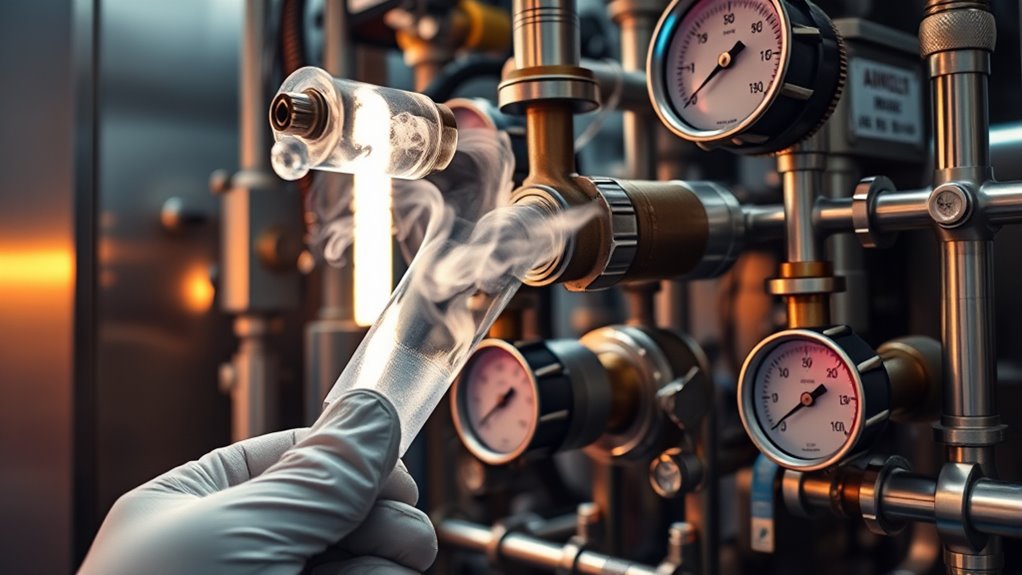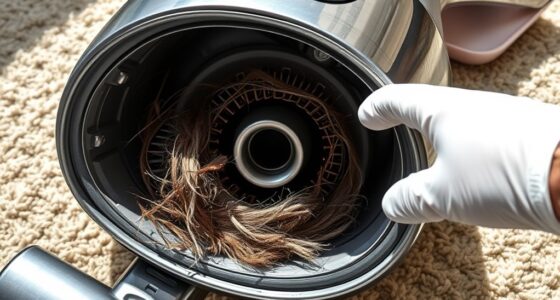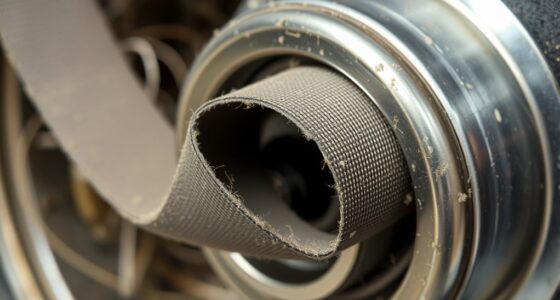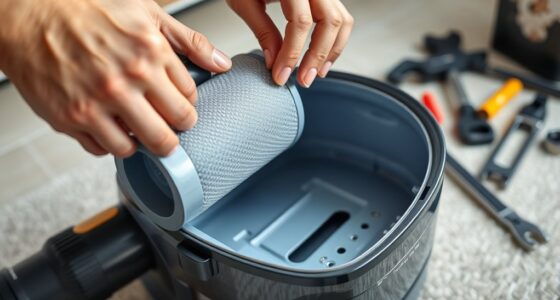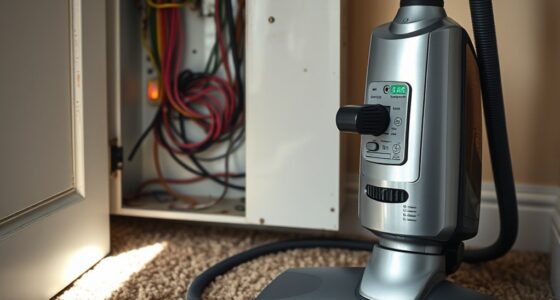To detect and fix air leaks in your vacuum system, start with a thorough visual inspection of seals, joints, and connections for signs of wear or damage. Use ultrasonic leak detectors and soapy water to pinpoint hidden leaks. Once identified, promptly replace damaged seals, tighten fittings, or reseal joints. After repairs, conduct pressure tests to guarantee leaks are sealed. Mastering these steps will help you maintain system efficiency and save energy—more tips await you.
Key Takeaways
- Conduct regular visual inspections of seals, gaskets, and connections to identify signs of wear or damage.
- Use pressure testing with high-quality gauges to detect pressure drops indicating leaks.
- Employ ultrasonic leak detectors and soapy water sprays to locate hidden or small leaks accurately.
- Promptly repair leaks by tightening fittings, replacing damaged seals, or resealing joints.
- After repairs, perform pressure tests to confirm leak resolution and maintain system efficiency.

Have you ever wondered how tiny air leaks can compromise the performance of your vacuum system? Even the smallest leaks can cause significant issues, reducing efficiency and increasing operational costs. Detecting these leaks early is vital to maintaining peak performance. One of the most effective ways to identify air leaks is through thorough seal inspection. During seal inspection, you carefully examine all gasketed joints, connections, and seals for signs of wear, cracks, or deterioration. Often, leaks hide in overlooked areas, so a meticulous visual check is essential. Look for hardened, cracked, or deformed seals, and replace any damaged components immediately. While visual inspection helps, it’s not always enough, especially for hidden leaks. That’s where pressure testing comes into play. Pressure testing involves sealing the system and pressurizing it with air or inert gases to see if the pressure drops over time. If it does, you’ve got a leak somewhere in the system. This method provides a clear, quantifiable way to confirm the presence of leaks and pinpoint their locations. When conducting pressure testing, you want to guarantee the system is properly sealed before pressurization. Use high-quality gauges to monitor pressure levels accurately, and set a specific duration for the test—usually 15 to 30 minutes—to observe any pressure fluctuations. If the pressure drops, it indicates air is escaping, and you’ll need to track down where the leak is. Sometimes, you can use ultrasonic leak detectors or soapy water sprays to help locate leaks during or after pressure testing. These tools make finding small leaks easier by highlighting escaping air. Additionally, understanding contrast ratio and how it affects image quality can help you identify issues with your projector’s performance, ensuring it operates at optimal settings. Once you’ve identified the leak, fix it promptly to restore your vacuum system’s efficiency. Repair might involve replacing damaged seals, tightening fittings, or resealing joints. Remember, even after repairs, it’s wise to perform another pressure test to confirm that the leak is fully sealed. Regular seal inspections and pressure testing should become part of your maintenance routine to catch leaks early and prevent costly downtime. Small leaks can quickly escalate into bigger problems if not addressed, so staying vigilant is key. By systematically inspecting seals and performing pressure tests, you can guarantee your vacuum system operates at peak performance, saving energy and reducing wear on components. Maintaining a proactive approach keeps your system reliable, efficient, and cost-effective in the long run.
Frequently Asked Questions
Can Small Leaks Significantly Affect Vacuum Efficiency?
Small leaks can substantially impact vacuum efficiency because they allow air to enter, reducing the system’s overall suction. To prevent this, you should focus on leak prevention through regular system maintenance. Checking for tiny cracks or loose fittings ensures your vacuum operates at peak performance. Ignoring small leaks might seem minor, but over time, they cause increased energy use and decreased efficiency, making consistent system maintenance essential.
What Are the Best Tools for Detecting Tiny Leaks?
Imagine your vacuum’s efficiency is a delicate ship steering stormy seas—tiny leaks can capsize it. You should use leak detection methods like soapy water for visual signs, ultrasonic leak detectors for pinpoint accuracy, or a helium leak detector for precision. Sealant recommendations include specialized vacuum-grade sealants, ensuring you seal even the smallest gaps effectively. These tools help you find leaks quickly and restore your system’s ideal performance.
How Often Should Vacuum Systems Be Inspected for Leaks?
You should inspect your vacuum system regularly to guarantee ideal performance. The ideal inspection frequency depends on your system’s usage and environment, but generally, leak monitoring should be done at least quarterly. Frequent inspections help catch leaks early, saving energy and preventing damage. Keep an eye on system performance and conduct leak monitoring more often if you notice any decline or unusual behavior, ensuring your vacuum system stays efficient and reliable.
Are There Temporary Fixes for Persistent Leaks?
If you have persistent leaks, temporary patching can help you manage the issue briefly. You might use leak sealants designed for your vacuum system, which can seal small leaks quickly. However, remember that these solutions aren’t permanent. For long-term fix, it’s best to identify and repair the underlying cause of the leak. Temporary patching and leak sealants are useful stopgap measures until you can make proper repairs.
Can Leaks Cause Damage to Vacuum System Components?
Think of your vacuum system as a delicate ship sailing smoothly; leaks are like unseen holes that threaten its voyage. Yes, leaks can damage components by causing strain, corrosion, or wear. Using vacuum sealants and leak prevention techniques helps patch these holes, ensuring your system stays seaworthy. Ignoring leaks risks costly repairs and reduced efficiency, so it’s crucial to address them promptly to protect your investment.
Conclusion
By actively detecting and sealing air leaks, you safeguard your vacuum system’s performance and longevity. Don’t let small leaks whisper away your efficiency—tackle them head-on. Remember, each leak fixed is like closing a door to wasted energy and costly repairs. Take control now, and transform your vacuum system into a fortress of reliability. Your efforts today guarantee smoother operations tomorrow—because a leak-free system isn’t just a goal; it’s your victory over inefficiency.
